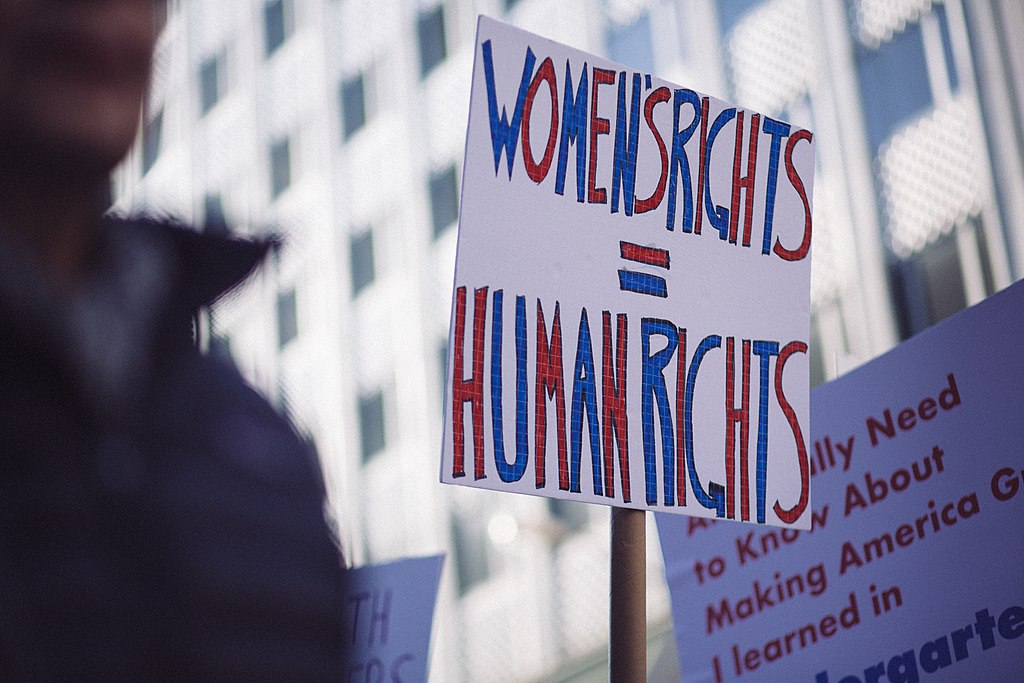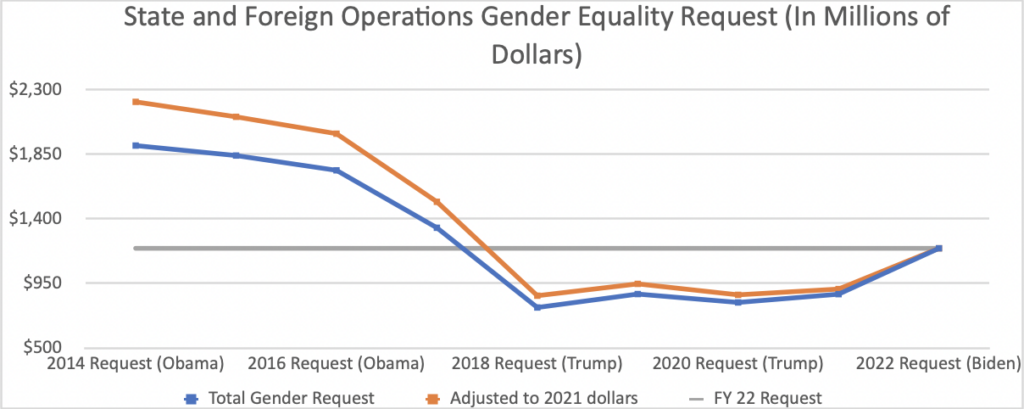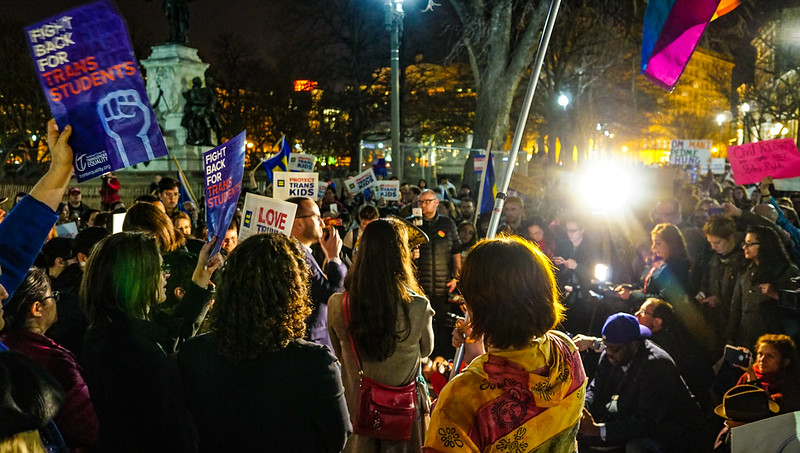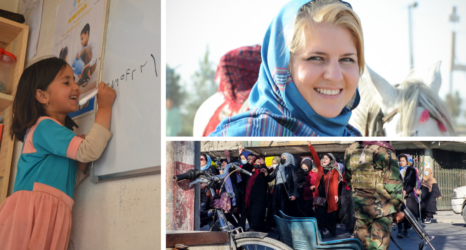The first-ever National Strategy on Gender Equity and Equality Strategy is an ambitious plan. But ambitious priorities require a significant budget to match.

The release of the first-ever National Strategy on Gender Equity and Equality Strategy on Friday, Oct. 22, marked a historic day in the United States. The whole of government strategy—with its 10 large-scale priorities and commitment to gender mainstreaming—is an ambitious plan and something the Biden-Harris administration and White House Gender Policy Council should be proud of and be celebrated for.
However, the hard part of implementing that strategy is just beginning. And ambitious priorities, like those laid out in the strategy, require a significant budget to match, in order for them to take root.
President Biden often highlights the words of his father: “Don’t tell me what you value. Show me your budget, and I’ll tell you what you value.” That said, will this strategy be backed with the funding needed for success? As it stands now, the U.S. has a long way to go in funding initiatives that ensure “gender is mainstreamed across the work of the federal government,” as the strategy calls for.
The U.S. has a long way to go in funding initiatives that ensure “gender is mainstreamed across the work of the federal government.”
In fact, in the global arena almost 80 percent of U.S. foreign aid fails to integrate or mainstream gender considerations—ranking the U.S third from last in gender equality funding. This was a reality I—and the over 80 organizations that called for a feminist foreign policy in the United States —hoped the Biden-Harris administration would shift with their first foreign policy budget request last May.
Unfortunately, while the President’s Budget Request for global gender equality, at that time, marked an increase from the past administration, it was lower than the lowest request from the Obama administration, and about a billion dollars lower than the Obama administration’s 2014 peak request for global gender equality efforts, in today’s dollars. (Inflation adjustment was done using the U.S. Bureau of Labor Statistics calculator assuming the request came out in February of the year prior to the fiscal year of the budget request as is typical and were adjusted to May 2021 dollars as this is when the fiscal year 2022 request was released.)

To successfully implement the new gender strategy, the U.S. foreign policy budget request must by far exceed the Obama administration’s $1.9 billion request, which did not include a commitment to integrate gender in all foreign policy initiatives, like the new gender strategy does. Without meaningful financial backing, rhetoric and verbal commitments to women’s rights, in the global arena, do little to stop the widening global gender gaps or ensure that women are included in foreign policy as a key human rights issue and component for development—including economic growth, food security, and longer lasting peace.
Without meaningful financial backing, rhetoric and verbal commitments to women’s rights do little to stop the widening global gender gaps.

To truly advance gender equality and ensure that women and girls are fully included in U.S. foreign policy, the administration must make greater, cross-cutting commitments to funding than they have in the past—and ensure that the necessary staffing, training and accountability mechanisms are in place to translate that funding into structural change. This includes non-binary and trans women and must include an intersectional analysis as women and girls’ experiences are not uniform and are impacted by their other identities like race, religion, ethnicity, sexual orientation or disability.
Concretely, the U.S. budget needs to integrate gender throughout 100 percent of foreign policy funding—and that means through foreign assistance, trade, defense, immigration, diplomacy, and COVID-19 response and recovery. It should increase dedicated funding for women’s rights organizations. And to match other global leaders, the budget should direct at least 20 percent of foreign assistance funding towards efforts centering gender equality—advancing women’s economic empowerment; curbing gender-based violence; and raising the bar in girl’s education, women’s leadership, and sexual and reproductive health and rights. The U.S. currently dedicates under 5 percent of its aid specifically focused on gender equality, while Canada and Spain spend over 20 percent. Underfunding like this just won’t cut it if this strategy is to succeed.
In order for the strategy to become a reality, commitments by the Biden-Harris administration and Congress must include increased funding for staff and training designed to build gender capacity at key foreign policy agencies and departments. Case in point: the U.S. Agency for International Development (USAID) has recently been required by policy and by law to integrate gender equality into all programs, activities, and strategies.
However, there was no request made for additional staff or training to scale up these efforts—and that even after an evaluation of the USAID gender policy found that an increase in staffing and capacity-building were essential. Will this new strategy take the necessary steps to fund gender experts, senior-level gender staff, and training to help staff mainstream gender at USAID and across all agencies?
These changes have the potential to significantly alter the trajectory for women and girls. In Afghanistan, for example, the impacts on women and girls would have been top priority prior to troop withdrawal, including assessing the different visa and refugee options open to women and human rights defenders that didn’t work directly with U.S. government agencies.
Within whichever diplomacy, humanitarian and development programs the U.S. funds moving forward, women’s rights organizations in Afghanistan would be funded, too. And all continuing funding to the country would mainstream gender. For example, a civil society strengthening activity would think through how to include women while addressing the barriers they may face in participating in those activities.
As the Biden-Harris administration prepares its budget request for 2023, they should show the world that they value gender equity and equality as much in their budget as they do in this strategy.
There are four key steps the administration and Congress can take together to turn the gender strategy into reality:
- commit to integrate a gender lens into all foreign policy funding;
- directly fund women’s rights organizations;
- scale up the resources for gender equality focused projects to 20 percent of all foreign assistance; and
- increase gender staffing and training across all foreign policy levers.
These critical and overdue actions will help ensure that women and girls are not left further behind and the gender equity and equality strategy is a success.
Up next:





